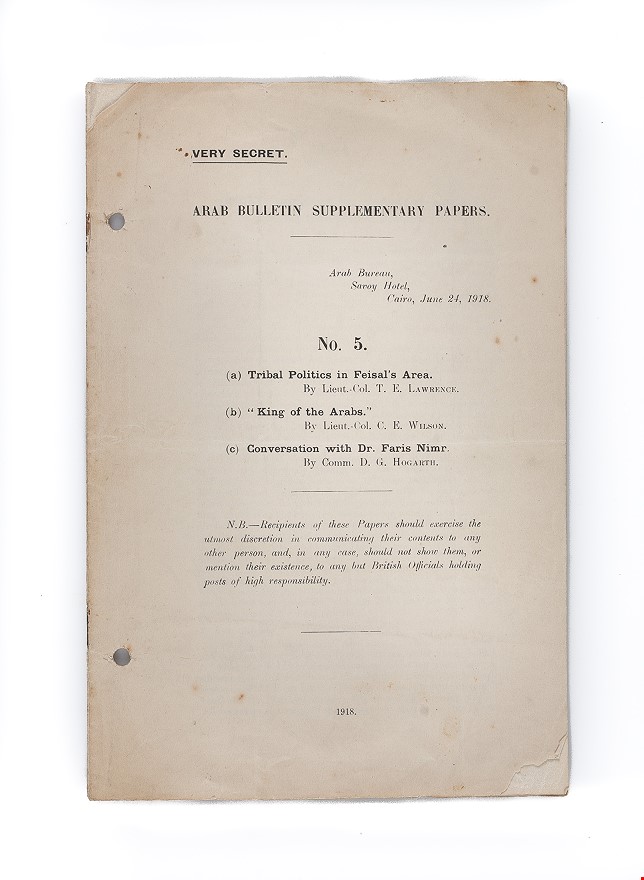Tribal Politics in Feisal's Area.
LAWRENCE T.E. (1918.)
£37500.00
Please contact us in advance if you would like to view this book at our Curzon Street shop.
One of three essays in Arab Bulletin Supplementary Papers. No. 5. Only edition, one of fifteen copies printed. Small folio, stapled as issued. 15pp, and title page which also serves as the wrapper. Cairo, Arab Bureau, Savoy Hotel, June 24
One of the greatest Lawrence rarities, unnoticed by the bibliographers and in none of the great American collections (quite possibly there is no copy in America). OCLC reports copies at the University of Durham and the Bodleian, and Jeremy Wilson cites one at the Public Records Office in London.
The essay by Lawrence is the fruit of his researches into the attitudes among the Arabs of the north of Palestine, made while planning an advance to Damascus led by an Arab army mounted on the 2000 camels donated by Allenby (as it turned out Feisal's army did take part in the advance to Damascus but not in as prominent a role as originally intended). The essay considers the state of affairs in the Howeitat, Beni Atiyah, Naimat, Hejaya, Hegeish, Beni Sakhr, Belgawiyeh, Ruwalla, Fadhld, and Naim tribes with notes on the situation at Kerak, Madeba and Maan. The text is written with Lawrence's usual mixture of clarity and precision leavened with occasional and unexpected bits of expressive writing and detached humour. How many other intelligence officers would have been content to name Metaab ibn Abtan, without the descriptive "a very intelligent, venturous, attractive boy of seventeen"? Or who else could have been as ironic as this passage: "Auda is as good as ever, but more wayward, if it be possible. He has now proved to his own satisfaction that his descent from the Prophet entitles him to equality with ordinary sherifs, if not to the actual title, and with Turkish prisoner-labour, he is building himself a great kasr of mud-brick at el-Jefer, and collecting 200 telegraph poles from the railway to roof it with." The detail in the report is astonishing: "Hatmal ibn Zebn is at Dhaba, intending to join Mithgal. Owaisi, his son, is with Murzuk at Towana. Nail is with Nasir, and Turki is just moving to Jial (Khan Zebib) to demolish something; Fahad and Mifleh are at Towana. The Gomaan have fallen out with Murzuk about pay, and are in bad odour with the other Beni Sakhr. Most of the Zebn tents are in Wadi Hamman, and they water from Themed . . .". One of the most important paragraphs is the one discussing Feisal's difficulty in delaying a revolt, since "a premature rising in the north, while he is enmeshed in the south, would break the frail fabric he is so carefully building up . . . Sherifian propaganda is complete to Damascus, and every possible supporter in that area is prepared for his coming. It remains to see whether there is fuel enough in their fire to keep them at rebellion pitch till he can use them." The battle for Arab hearts and minds continures: "The Turks have extended their humanity and toleration campaign by sending Feisal further letters proposing an adjustment. Feisal has sent back elastic and obscure replies, tending to maintain the Turkish hope that accommodation may some day be possible. It seems a pity, by unnecessary brusqueness, to pull together into firm opposition the many old-Turk and liberal-Turk elements who now half believe the Sherif justified, and take an unconscious pleasure in seeing the Arabs defeat the Germano-Turk General Staff party in the field." The other two essays in this supplement are not insignificant either. Lieut-Col C.E. Wilson in "King of the Arabs" recounts in great detail an account of a meeting with King Husein in which they discuss in considerable detail the government of the future Arab state, whether his title can be extended from King of the Hejaz to King of the Arabs, the difference between political warfare and Jehad (religious war) and the Sykes/ Picot "arrangement", and D.G. Hogarth, Lawrence's archaeological mentor, reports on a fascinating conversation with the influential Syrian born, Egypt-based newspaper proprietor Dr. Faris Nimr, who argued against Syrian incorporation into a theocratic state governed from the Hejaz, and also argued "with heat and emphasis" that "British Palestine must not be a step to a Jewish Palestine.
The whole is a fine example of the quality of information which made the British Intelligence Officer such a legendary figure in the middle east. As far as rarity goes, it is hard to imagine a printed document more rare than this. The Arab Bulletin itself is notoriously scarce. There is a set in the Metcalf collection at the Huntington Library, which is probably that sold at auction in 1968 (a bargain £650 to Duschnes) but we know of no other set having been sold. The numbers printed of the Arab Bulletin itself steadily increased from 25 to 75, by which time the French government were receiving copies, and it was considered then that the circulation was too wide for the most secret material, which was printed in a series of supplements such as this for the most limited readership.
Corners a little folded back, with a very little loss, a short tear to the lower wrapper, two vertical and one horizontal folds, a pair of filing holes in the gutter, and a couple of later manuscript notes in the text.
Stock Code: 225536




